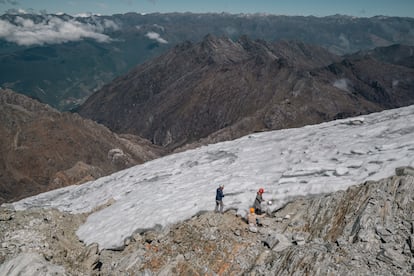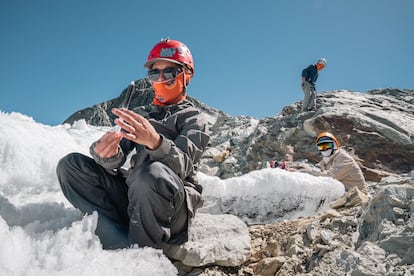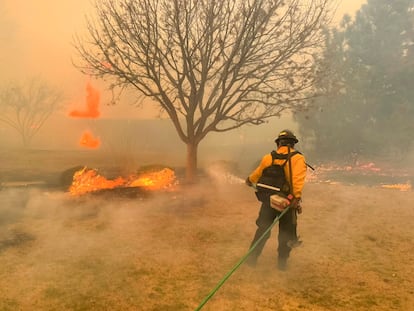A thermal cover at 16,500 feet: Maduro’s strategy to save the last glacier in Venezuela
The authorities have covered a piece of ice smaller than a soccer field with a geotextile blanket, in an operation that has raised criticism from scientists and environmentalists


In 1956, European and Venezuelan skiers slid through the mountains of Pico Espejo, in the Andean state of Mérida, in the first and only cross country skiing championship to be held in Venezuela. The Venezuelan Andean Club, which organized the competition, aspired to demonstrate that people could ski in a tropical country. The images of that event are evidence of a feat conceived at 15,500 feet above sea level. They also serve as a reference to show how in just 70 years the climate change caused by global warming has destroyed all the glaciers that allowed Venezuelans to dream of skiing in their own country.
The last Venezuelan glacier, which has so far resisted melting, is on the Humboldt Peak of the Sierra Nevada National Park in Mérida. The glacier is in its final days, and in the Andean city the locals are preparing for its disappearance with protests. There are also concerns from the scientific community over the renewed aspirations of the Chavista government of trying to artificially extend the life of a sheet of ice smaller than a football field, less than five acres, from the more than 750 acres it had at the beginning of the last century.
Venezuela’s environmental authorities have undertaken a costly maneuver to cover what remains of La Corona glacier with a geotextile cover, similar to those used in alpine countries to protect ski slopes during the summer. In December, President Nicolás Maduro asked scientists to make “every effort” to save the glacier. A few weeks ago, the ruling party’s governor of the state of Mérida, Jehyson Guzmán, appeared in photos carrying one of the 35 rolls of thermal blankets acquired by the government to slow down the melting. The plan has the ambitions of a military operation. To deploy this polypropylene cover, weighing 80 kilos each, two air force helicopters and more than 100 people have been sent up the steep summit.
At the foot of the mountain, in the Plaza Bolívar in Mérida, environmentalists, mountaineers, and city residents have organized a petition this week to collect signatures rejecting the government’s operation and demanding the removal of the geotextile cover. They are asking the government to abort the plans that are still underway. “No to plastic” is one of the main slogans, which reflects one of the concerns about this measure.
“The reduction of the glacier is a natural process that has been accelerated by climate change in recent years,” explains Professor Elides Sulbarán, a forestry engineer, specialist in spatial planning, and a member of the International Union for Conservation of Nature’s World Commission on Protected Areas. “The retreat of glaciers has been recorded since the end of the 19th century. Don Tulio Febres Cordero, in his newspaper El Lápiz, reported the notable reduction of the sections of the mountain range covered by glaciers. In 1910 Alfredo Jahn reported the on this process in his mapping expeditions, as did Carlos Schuber in 1950.” A 2018 ruling prohibited climbing and entering the Humboldt Glacier with crampons, due to the instability of the surface.

The process of glacial melting, especially tropical glaciers, is inexorable. The Intergovernmental Panel on Climate Change has stated that this phenomenon is a key indicator for evaluating the effects of global warming. That is why scientific sectors in Venezuela have warned that the surface that the government is trying to save can no longer be considered a glacier. And they question the costly investment in a measure that will have no effect and could generate greater consequences such as contamination by microplastics resulting from the decomposition of the thermal material, as warned in statements from different unions.
“By covering the mountain with plastic, the national park’s plan is undermined and it will cause a serious alteration in the landscape. This happens unexpectedly and without knowing the environmental impact studies required by law,” warns Sulbarán, who for 30 years worked at Inparques, the organization that oversees protected areas in Venezuela.
Life conquers the void
In the absence of snow, there has been an avalanche of uncertainty. Physicist and researcher Alejandra Melfo is part of the Venezuela’s last glacier project, supported by the National Geographic Society, the University of Los Andes, the National Observatory against Climate Change, and other international partners. In collaboration with these organizations, she has been able to make recent evaluations of the situation of La Corona glacier.
At the end of 2023, she climbed to the top and saw that it was gray and very cracked, with gaps in which small holes have formed. Her team is not part of the operation carried out by the government. “Covering of glaciers is nothing new, but it has never been done in tropical glaciers that do not have winter and summer. Nor has it been done on a glacier in that state. We don’t know what might happen,” Melfo says on the phone from Mérida.
The researcher is accumulating questions on which she seeks information, such as the frequency with which the government plans to uncover the glacier, what areas are going to be covered, what the numbers are that support this operation, and what effects the logistics of covering and uncovering the glacier might cause in such a delicate ecosystem.
“It’s hard to even know how much mass is left. There are no glaciologists in Venezuela.” Venezuela will be the first Andean country to have lost all its glaciers. And in the coming months, with the coming of the El Niño phenomenon, the reduction in rain and the increase in heat could be factors that accelerate this process. “The Earth has gone through many climate changes, but we are causing this one,” the scientist warns.

Melfo has dedicated her career to researching primary succession processes, meaning what happens to exposed rock after the retreat of glaciers. She studies life after the thaw. “There are microorganisms that live in the ice and they are going to disappear, and if you don’t study them you won’t know they existed. Life will always fill empty spaces. What we don’t know is how nature does it. Along the slope that is getting warmer, plants like mosses and lichens that live lower down are beginning to climb and create facilitating interactions. We have seen that in hostile spaces, there are more facilitations and the plants do not compete, but rather cooperate with each other,” the native Uruguayan researcher who adopted Venezuela as her home more than forty years ago says.
In addition, there are GLORIA stations, a global initiative to monitor climate change at the summits in several parts of this mountain range. “Without boots and without pay, we ecologists continue going up to the mountains to do studies.”
Where the cover is placed may compromise the continuity of the microbiology studies on the glacier, which until now were carried out in an almost pristine environment and without interventions. One of the main findings of this research, Melfo points out, is that given the speed with which the glacial melting is advancing due to global warming, the recomposition of a new ecosystem occurs very slowly. That is why taking measures in the face of what the Humboldt glacier is showing is so urgent. “In these cases the recommendations are always the same. We should use what is happening in Humboldt to implement climate change adaptation measures, such as reducing the use of fossil fuels. It is not true to say that it’s impossible to find other sources of energy.”
Sign up for our weekly newsletter to get more English-language news coverage from EL PAÍS USA Edition
Tu suscripción se está usando en otro dispositivo
¿Quieres añadir otro usuario a tu suscripción?
Si continúas leyendo en este dispositivo, no se podrá leer en el otro.
FlechaTu suscripción se está usando en otro dispositivo y solo puedes acceder a EL PAÍS desde un dispositivo a la vez.
Si quieres compartir tu cuenta, cambia tu suscripción a la modalidad Premium, así podrás añadir otro usuario. Cada uno accederá con su propia cuenta de email, lo que os permitirá personalizar vuestra experiencia en EL PAÍS.
¿Tienes una suscripción de empresa? Accede aquí para contratar más cuentas.
En el caso de no saber quién está usando tu cuenta, te recomendamos cambiar tu contraseña aquí.
Si decides continuar compartiendo tu cuenta, este mensaje se mostrará en tu dispositivo y en el de la otra persona que está usando tu cuenta de forma indefinida, afectando a tu experiencia de lectura. Puedes consultar aquí los términos y condiciones de la suscripción digital.
More information
Archived In
Últimas noticias
There is as much life left to discover on planet Earth as that which is already known
Dozens presumed dead, around 100 injured in fire at Swiss Alps bar during New Year’s celebration
Is porn for women different from conventional porn? We spoke to those who make it
Cartagena de Indias is sinking: What can the city do to mitigate it?
Most viewed
- David King, chemist: ‘There are scientists studying how to cool the planet; nobody should stop these experiments from happening’
- Reinhard Genzel, Nobel laureate in physics: ‘One-minute videos will never give you the truth’
- Oona Chaplin: ‘I told James Cameron that I was living in a treehouse and starting a permaculture project with a friend’
- Sinaloa Cartel war is taking its toll on Los Chapitos
- The Interoceanic Train, the Mexican alternative to the Panama Canal









































